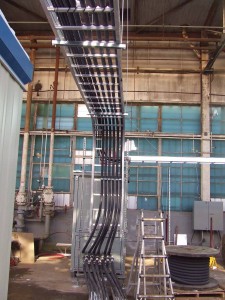
Award of Excellence: Outboard Marine In Situ Environmental Remediation
October 24, 2015
By Dillon Consulting
“This old small engine manufacturing facility site in Peterborough, Ontario was contaminated with DNAPLs like lubricating oils and degreasing fluids. To remediate the land the engineers applied an in situ thermal process that has not been used in Canada before, called electro-thermal dynamic stripping.” – Jury
From the October-November 2015 print edition, p. 59

Outboard Marine In Situ Environmental Remediation. Photo: Dillon Consulting.
In the late 1980s, the Outboard Marine Corporation of Canada (OMCC) began wrapping up operations at their Peterborough manufacturing facility where they had been building small engines for nearly 75 years.
Environmental investigations by Dillon revealed the presence of a significant number of legacy environmental issues, including a subterranean pool of degreasing fluid used in the manufacturing processes. The pool consisted of an estimated 10,000 litres of dense non-aqueous phase liquid, or “DNAPL,” composed primarily of trichloroethylene. Emanating from this pool was a dissolved-phase groundwater plume of volatile organic compounds extending some 800 metres from the OMCC facility into an area of residential dwellings and small commercial establishments.
In 2000, OMCC filed for creditor protection under Canada’s Companies Creditors Arrangement Act (CCAA). The following year Dillon was court-appointed as the Environmental Remediation Receiver (ER Receiver) for OMCC, with a court mandate to act on its behalf on environmental matters. This receivership structure is the first of its kind to be established within the CCAA framework. This project is therefore an example of an engineering firm expanding beyond the boundaries of traditional engineering services.
Managing the DNAPL contamination
Between 2001 and 2013, activities to isolate, manage and remediate the DNAPL contamination were implemented.
Acting as ER Receiver, Dillon successfully administered the remediation of the DNAPL pool in 2010 through 2013 using an in situ thermal process, the Electro-Thermal Dynamic Stripping Process (ET-DSP). While this is Canadian technology and has been used successfully in the U.S., this project was the first application of ET-DSP in Canada.
The ET-DSP technology involves heating soil in the saturated and unsaturated zones by passing current between buried electrodes, while water is simultaneously circulated through the electrodes.
A network of extraction wells was installed to act as collection points for the contaminants. A multi-phase extraction system was used to induce a high vacuum at each of the extraction wells, promoting the flow of contaminants into these wells.
The application of ET-DSP allowed for the extracted contaminants to be treated at a centralized treatment system. The vapour was treated by passing through activated carbon; phase-separated liquids were collected and sent for recycling; and water was treated using air-stripping and carbon filtration.
Site complications and selecting
ET-DSP technology
The remediation of the DNAPL source zone was complex given the nature of the contaminant. Its presence 3 to 4 metres below the water table, and at a depth of 6 to 7 metres below ground under an active warehouse containing museum artifacts (the Canadian Canoe Museum), provided complications, as did the need to achieve complete clean-up. Further, the site’s position within a mixed commercial-residential area of Peterborough required that the remediation activities minimized residents’ and workers’ exposure to contaminants and to disruptions.
To address these challenges, Dillon’s approach included the use of a fixed-price, performance-based remediation contract for the remediation work whereby targets and timelines were developed and the proponent was responsible for a process of their choosing. Dillon completed a request for proposal and a quantitative metric-based evaluation process. Through this process the remediation technology, ET-DSP developed by McMillan McGee of Calgary was selected. The approach minimized building disruption and exposure to remediation activities, provided the greatest certainty of success, was cost-effective and could be completed in a relatively short timeframe.
The remediation of the legacy environmental contamination at the OMCC facility resulted in two positive outcomes. The first was that it removed a major environmental liability on the former OMCC property. The second was that it negated the need for off-site measures to address contamination emanating from the OMC facility. Post-remediation monitoring by the Ontario Ministry of Environment and Climate Change confirmed that levels of contaminants in the groundwater have remained low. As a result, other measures implemented as part of the Remedial Action Plan (e.g. pump-and-treat system) have recently been suspended.
The remediation increased the property values of the adjacent lands. It removed a multi-million dollar environmental liability on property located within the City of Peterborough and it benefits the site’s re-use as a converted brownfield.
The ER Receiver concept provided a means of addressing legacy environmental issues left by an insolvent company in an effective manner, avoiding a protracted process that would have delayed or derailed the environmental remediation indefinitely.
Project name: Outboard Marine (OMC) In Situ Environmental Remediation, Peterborough, Ont.
Award-winning firm (project director/receiver/prime consultant):
Dillon Consulting, Toronto (Andrew Wilson, P.Eng., Sean Salvatori, P.Geo., Tom Grimminck, P.Eng., Rob Kell, P.Eng. P.Geo., Renee Recoskie, Darin Burr, P.Geo., Sherry Dosman, AScT, Louis Tasfi, Ph.D., P.Eng., Shayne Giles, P.Eng., Shawna Boakes, P.Eng.)
Owner-client (court-appointed Environmental Remediation Receiver for Outboard Marine Corporation of Canada ): Dillon Consulting
Subconsultants: McMillan McGee (ET-DSP remediation technology)
Other key players: Miller Thomson (legal), Ernst & Young
(Disbursement Receiver)